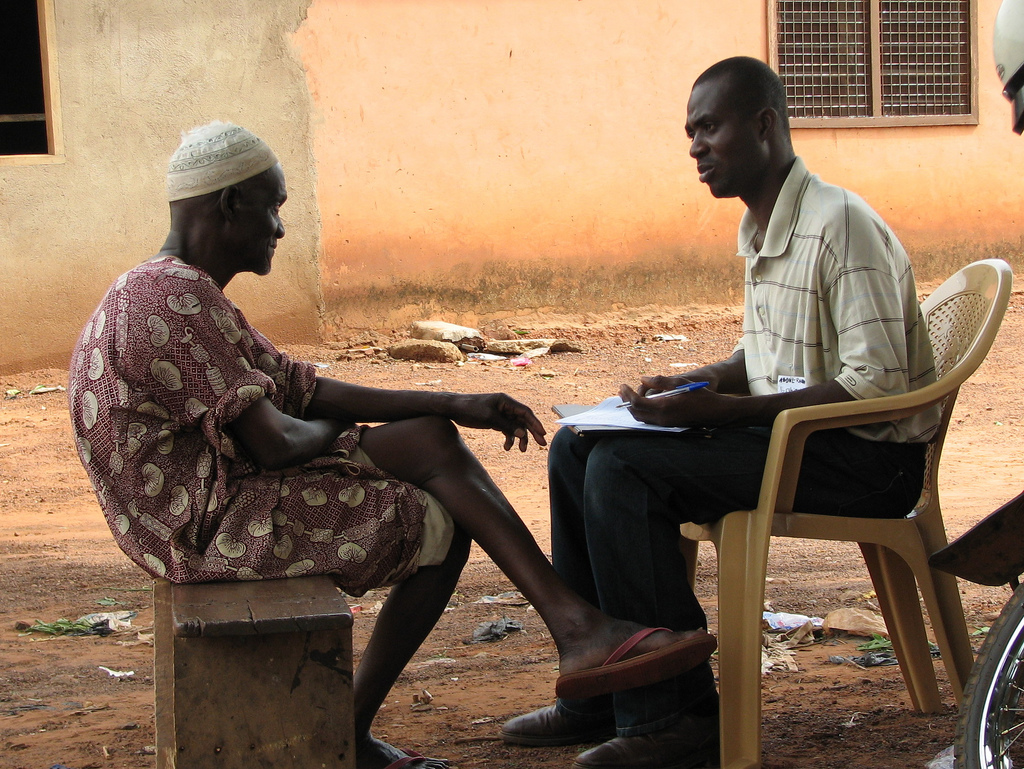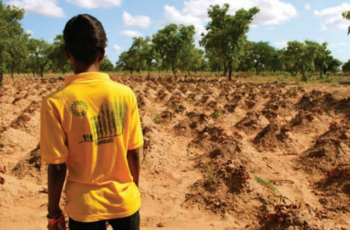Overview
Researchers
Christopher Udry
Henry J. Heinz, II Professor of Economics at Yale University
Dean Karlan
Professor of Economics & Finance at Northwestern University, and the President and Founder of Innovations for Poverty Action (IPA)
Edward Asiedu
Senior LecturerUniversity of Ghana
- Country
- Ghana
- Timeline
- 05/01/2018 - 09/30/2021
- Constraints
- Credit, Information, Input and Output Markets
- Technology Category
- Contracts, Extension, Improved Seed, Inputs
- Sample
- 130 communities in northern Ghana

IPA enumerator interviewing a local farmer about his plans for his maize (corn) crop this year. Photo credit: Innovations for Poverty Action (IPA)
For millions of smallholder farmers in Sub-Saharan Africa, the shift from subsistence agriculture to engagement with markets is a promising way to improve rural livelihoods. However, engaging with markets often requires the difficult task of adopting new inputs, such as improved seed varieties and fertilizers, as well as implementing new farming techniques. Researchers are partnering with the Savanna Farmers Marketing Company (SFMC) to evaluate the impact of a contract farming program that encourages the uptake of new technologies on the adoption of high yielding seeds in northern Ghana.
Policy Issue
For millions of smallholder farmers in Sub-Saharan Africa, the shift from subsistence agriculture to engagement with markets is a promising way to improve rural livelihoods. However, engaging with markets often requires adopting new inputs, such as improved seed varieties and fertilizers, as well as implementing new farming techniques, processes that pose a host of potentially prohibitive challenges. For example, farmers may struggle to access improved seeds and may not have the necessary information or access to equipment to profitably cultivate new crop types. Developing effective ways to increase the adoption of new seeds and techniques is thus a key policy issue for agricultural development. Past research has looked at how information, risk, and credit individually impact farmers’ decisions to adopt new inputs and techniques. However, relatively little research examines the intersection of these constraints or strategies that address multiple constraints with the same program model.
Context of the Evaluation
In northern Ghana, where hunger and poverty are more prevalent than in the rest of the country, small-scale farmers rely on subsistence farming with low productivity and face exclusion from the rapidly growing national agriculture markets. New technologies such as seeds and farming techniques are required to increase farmers’ productivity and profits. However, the agricultural practices currently recommended by the Ministry of Food and Agriculture (MoFA) for crops grown in northern Ghana, even when adopted, are often not profitable.
Two seed varieties might provide an answer to this issue: soy and a high-yielding maize seed developed by Pioneer in South Africa. The adoption of both types of seeds has been shown to increase profits per acre in pilot farms in Ghana. In addition, soy is primarily cultivated by women in Ghana, so increased adoption of soy seeds could lead to improved incomes for female farmers in the region.
There are four likely barriers to the adoption of these new seeds. First, farmers may be reluctant to grow Pioneer maize and soy because there is not enough market demand for these products, and farmers may struggle to find buyers at harvest time. Second, the costs per acre of cultivating Pioneer yellow maize are far higher than the costs of cultivating a similar plot using current seeds and techniques. Third, a lack of coordination in the market for tractor plowing may lead to higher costs for tractor services, which could be a key barrier given that both soy and Pioneer maize require timely plowing of fields to maximize yields. Fourth, farmers may simply lack the information necessary to adopt the new technologies.
Details of the Intervention
Researchers are partnering with the Savanna Farmers Marketing Company (SFMC) to evaluate the impact of a contract farming program on the adoption of soy and Pioneer maize seeds in northern Ghana. SFMC’s contract farming program provides two key services for farmers: (1) contracts with Farmers’ Organizations (FO) to purchase their crops at a guaranteed minimum price and (2) loans and coordination of timely tractor services paid for with interest in the form of crops at harvest time, as timely plowing is critical for cultivating soy and Pioneer maize. If the market price at harvest exceeds the guaranteed minimum price, SFMC pays the farmers at the higher rate. In addition, SFMC sends personnel to each FO monthly to provide sessions on best practices for agricultural productivity and profit.
Researchers will randomly assign 200 communities in northern Ghana to one of four groups:
- Basic contract group: 43 communities will receive SFMC’s contract offer and information about the newly available seeds.
- Contract, extension, and credit group: 44 communities will receive SFMC’s full program: contract offer, coordination and credit for tractor services, and monthly sessions on best practices. They will also receive a grant equivalent to the value of a starter kit of Pioneer seeds and fertilizer.
- Enhanced extension group: 43 communities will receive SFMC’s full program with more frequent weekly extension sessions. The more frequent sessions will provide consistent reminders at key points in the planting season, building on a model shown effective at changing farmer behavior in a previous trial. The frequent visits also allow SFMC staff to provide short-term weather forecasts, which can further improve farming yields. Group 3 will also receive subsidized access to the starter kit of Pioneer seeds for the first farming season of the program.
- Comparison group: 70 communities will receive only an announcement of the availability of the new seeds.
Researchers will gather information on three outcomes over two years to evaluate the impact of the different approaches. The first outcome will be the change in farmers’ crop portfolio in the second farming season toward more soy and Pioneer maize seeds, as well as the access to and timing of tractor services. The second outcome will be farmers’ knowledge of the new seeds and techniques and decision making about their adoption. The third outcome will be farmers’ productivity, profits, and farming incomes.
Results and Policy Lessons
Evaluation ongoing, results forthcoming.
